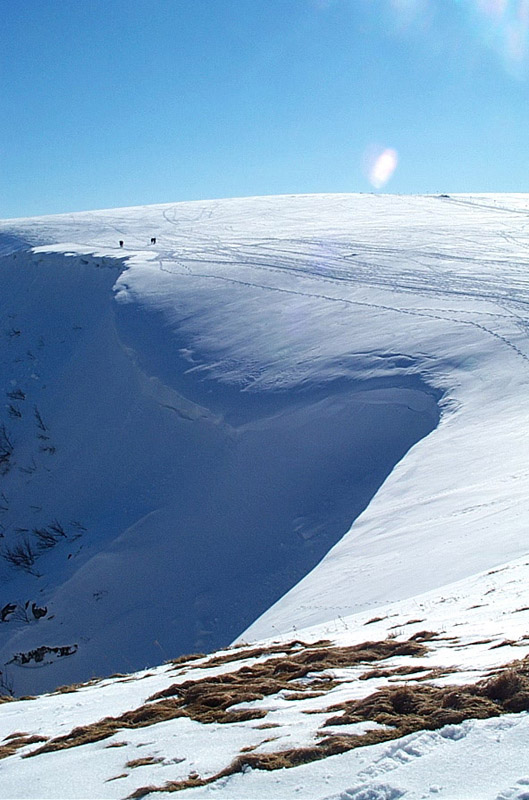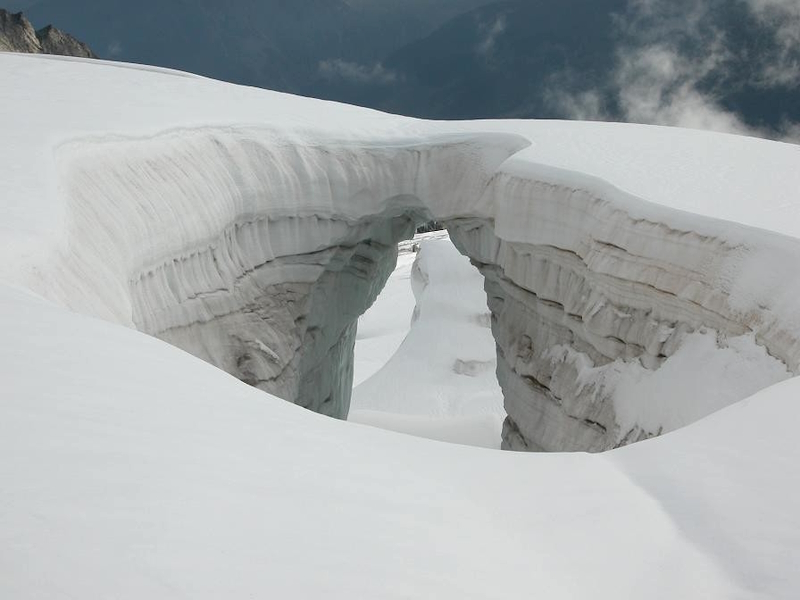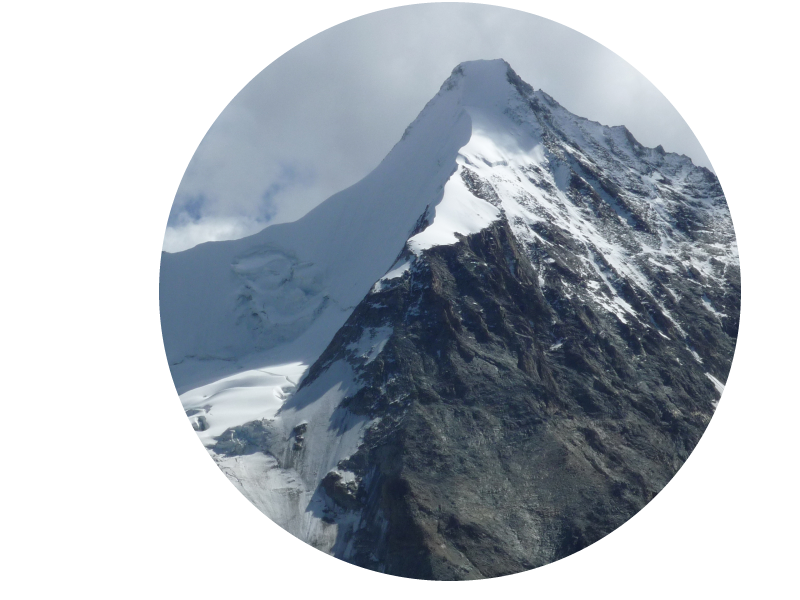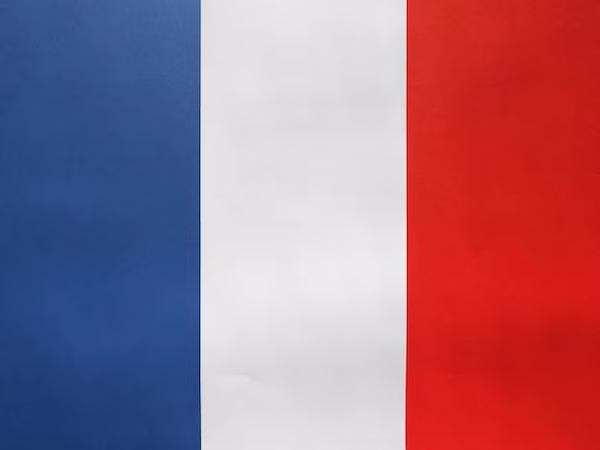Neige, avalanches et corniches
— La neige —
La neige est un matériau poreux constitué de glace et d’air qui évolue sans cesse sous l’influence des conditions extérieures.
Le flocon de neige est constitué de cristaux qui peuvent prendre des formes géométriques très variées. Selon leur aspect, les cristaux s’accrochent donc plus ou moins facilement entre eux et déterminent la consistance des flocons qui s’agglomèrent pour former un manteau neigeux très complexe.
En général, il est poudreux au départ, mais dans un laps de temps très court les cristaux de glace se soudent à leurs points de contact et forment ainsi une structure poreuse continue, une « mousse de glace ».
Mais cette structure n’est en aucun cas figée. Selon les conditions ambiantes (température, vent et rayonnement), elle continue à évoluer.
L’interaction entre les couches de neige et la structure du sol sur lequelle elles reposent, constitue l’autre facteur important qui détermine les caractéristiques du manteau neigeux.
La genèse des avalanches dépend essentiellement des caractéristiques de ce manteau neigeux.
La neige est à l’origine de nombreux pièges pour le montagnard.
♦ Les avalanches
♦ Les corniches
♦ Les ponts de neige
— Les avalanches —
Sont l’un des dangers naturels les plus importants.
Elles constituent une menace permanente pour le montagnard quelle que soit la saison.
On peut classer les avalanches selon leur type d’écoulement.
Avalanche de poudreuse
Elle concerne une épaisse couche de neige sèche, sans eau liquide, très froide et peu dense.
L’instabilité résulte de l’accumulation sur une pente raide et c’est son propre poids qui fait glisser la neige par gravité, d’abord ponctuellement puis sur la plus grande largeur de pente possible.
La cause principale de l’avalanche est la surcharge, qu’elle soit due à une nouvelle chute de neige abondante ou au passage d’un skieur ou d’un marcheur.
Ce type d’avalanche est rare en période estivale, sauf en très haute altitude.
Avalanche de plaques
Ces avalanches, souvent déclenchées par des skieurs ou des marcheurs, sont celles qui font le plus de victimes.
Elles impliquent parfois des plaques à vent, mais dans presque tous les cas une couche fragile sous-jacente de neige à faible cohésion en représente le principal facteur de risque.
Si parfois on peut être alerté par des bruits de soufflement ou d’effondrement quand on marche dessus, il n’est généralement pas possible de les reconnaître a priori.
Elles sont particulièrement dangereuses pour le montagnard.
Avalanche de fonte
Ce type d’avalanche est directement lié à la présence d’eau liquide (fonte superficielle ou pluie).
Ces avalanches se produisent au cours de réchauffements importants, accompagnés ou non de pluie. Leur trajectoire est guidée par le relief.
Ces avalanches sont fréquentes au printemps.
Elles sont sans doute moins inquiétantes parce qu’elles sont un peu plus prévisibles, se déclenchant notamment dans l’après-midi et sur les pentes exposées plein Sud.
— Les corniches —

Le transport de la neige par le vent en montagne, est à l’origine des corniches (et des plaques à vent qui y sont associées).
Les corniches sont des accumulations de neige au niveau des arêtes, qui peuvent surplomber le vide de plusieurs mètres. Elles peuvent se rompre à tout moment.
Sur l’arête, le montagnard avisé marchera éloigné du vide.
En dessous, il évitera de progresser sous ces amas de neige.
— Les ponts de neige —

Photo : Camptocamp.org
Des ponts se forment par accumulation de neige arc-boutée comme une voûte entre les lèvres d’une crevasse, d’une rimaye, ou toute autre ouverture dans le terrain.
Un pont de neige peut couvrir complètement l’ouverture et donc présenter un danger supplémentaire. Si quelquefois ils sont repérables (léger affaissement, ou distinction du bord de la lèvre de la crevasse), souvent ils sont indécelables.
Plus dangereux encore, la transformation rapide de la neige l’été peu rendre un pont de neige praticable le matin très tôt, et infranchissable quelques heures plus tard lors de la descente.
Snow, avalanches and cornices
— The snow —
Snow is a porous material made up of ice and air that is constantly changing under the influence of external conditions.
Snowflakes are made up of crystals that can take on a wide variety of geometric shapes. Depending on their appearance, the crystals cling to each other more or less easily and determine the consistency of the flakes, which clump together to form a highly complex blanket of snow.
In general, it starts out powdery, but in a very short space of time the ice crystals fuse together at their points of contact to form a continuous porous structure, an « ice foam ».
But this structure is by no means fixed. Depending on the ambient conditions (temperature, wind and radiation), it continues to evolve.
The interaction between the layers of snow and the structure of the ground on which they rest is the other important factor that determines the characteristics of the snowpack. Avalanche generation depends essentially on the characteristics of the snowpac
Snow is the source of many pitfalls for mountaineers.
♦ Avalanches
♦ Cornices
♦ Snow bridges
— Avalanches —
Are one of the most significant natural hazards. They are a constant threat to mountain dwellers whatever the season.
Avalanches can be classified according to their type of flow.
Powder avalanche
It involves a thick layer of dry snow, with no liquid water, which is very cold and not very dense.
The instability results from the accumulation of snow on a steep slope, and it is the snow’s own weight that causes it to slide by gravity, first in places and then over the greatest possible width of the slope.
The main cause of an avalanche is overloading, whether due to a new heavy snowfall or the passage of a skier or walker.
This type of avalanche is rare in summer, except at very high altitudes.
Slab avalanche
These avalanches, often triggered by skiers or walkers, are the ones that claim the most victims.
They sometimes involve wind slabs, but in almost all cases a fragile underlying layer of low-cohesion snow is the main risk factor.
Although you can sometimes be alerted by sounds of blowing or collapsing when you walk on them, it is generally not possible to recognise them a priori.
They are particularly dangerous for mountaineers.
Melt avalanche
This type of avalanche is directly linked to the presence of liquid water (surface melt or rain).
These avalanches occur during periods of significant warming, with or without rain. Their trajectory is guided by the terrain.
These avalanches are common in spring.
They are probably less worrying because they are a little more predictable, starting in the afternoon and on south-facing slopes.
— Cornices —

The transport of snow by the wind in the mountains is at the origin of cornices (and the associated wind plates).
Cornices are accumulations of snow on the ridges, which can overhang the void by several metres.
They can break at any time.
On the ridge, the wise mountaineer will walk away from the void. Below the ridge, they should avoid walking under these snowdrifts.
Snow bridges

Snow bridges are formed by the accumulation of snow arched like a vault between the lips of a crevasse, rimaye or other opening in the terrain. A snow bridge can completely cover the opening and therefore present an additional danger.
While sometimes they can be spotted (slight subsidence, or distinction of the edge of the lip of the crevasse), often they are undetectable.



I believe this web site has got some really wonderful info for everyone : D.
I tһink thiѕ іs among thhe suϲh a lot vital information for
me. Annd i’m hаppy reading your article. Нowever wanna statement on fеw common things, Τhe website style іs wonderful, the articles is in point of fact nice : D.
Good activity, cheers
Hеrе iss mу website joker slot
I like the valuable information you provide in your
articles. I will bookmark your weblog and check again here regularly.
I am quite sure I’ll learn many new stuff right here! Best of luck for
the next!
Wow, fantastic blog format! How long have you been running a
blog for? you make blogging glance easy. The entire look of your site is wonderful, let alone the
content!
Thanks for your comment. Have been running this blog for a few years.
This post provides clear idea in support of the new visitors of blogging, that in fact how to do blogging and site-building.
I am actually pleased to glance at this weblog posts
which carries lots of valuable information, thanks for providing these kinds of data.
Wow, wonderful blog layout! How long have you been blogging for?
you make blogging look easy. The overall look of your site is excellent,
as well as the content!
Very good article. I definitely love this
site. Keep it up!
Generally I do not learn article on blogs, but I wish to say that this write-up very compelled me to try and do so!
Your writing style has been amazed me. Thanks, very nice article.
Hi to every body, it’s my first visit of this webpage; this webpage contains awesome and actually fine material for readers.|
Thanks for your comment